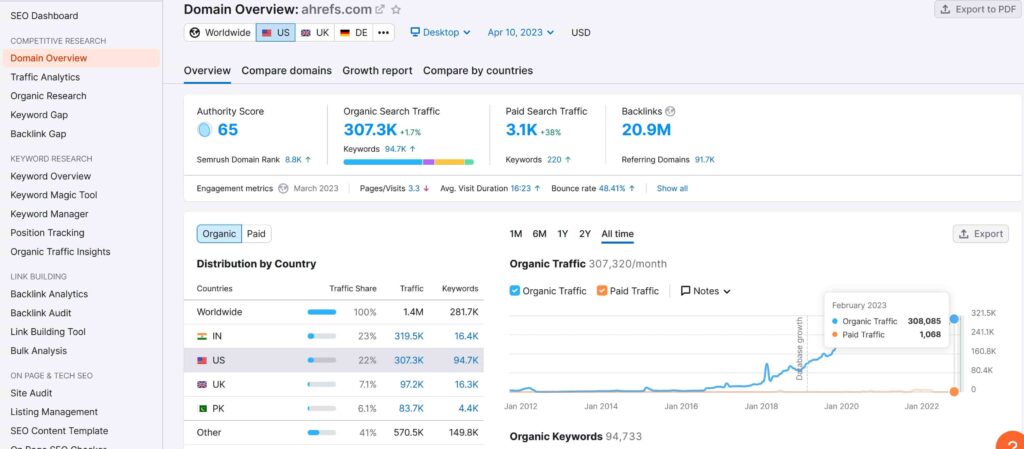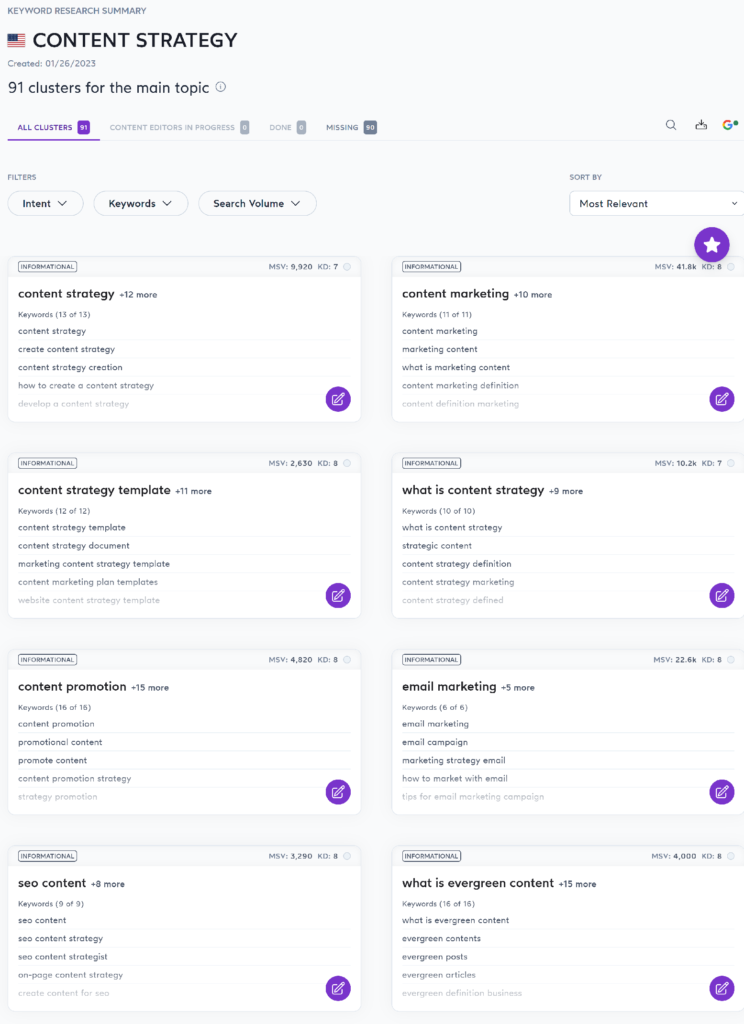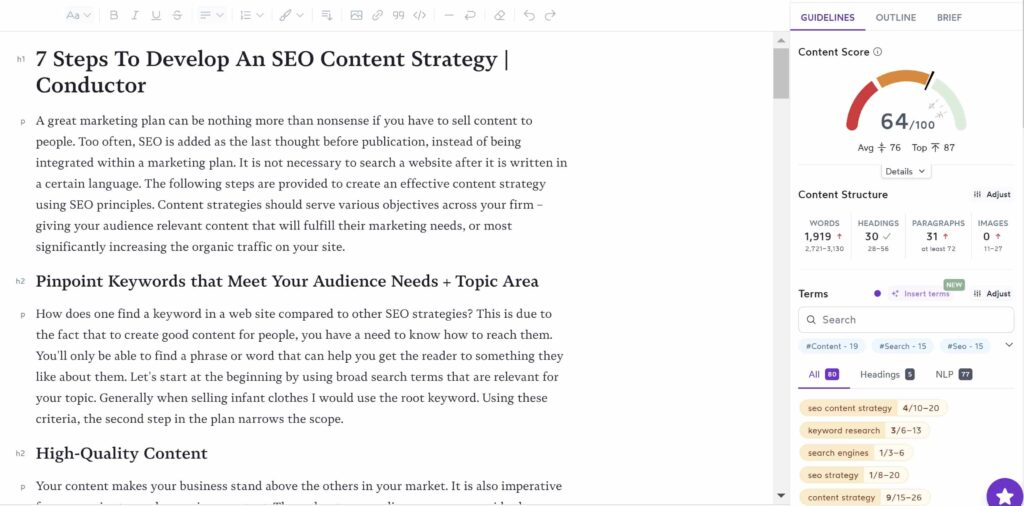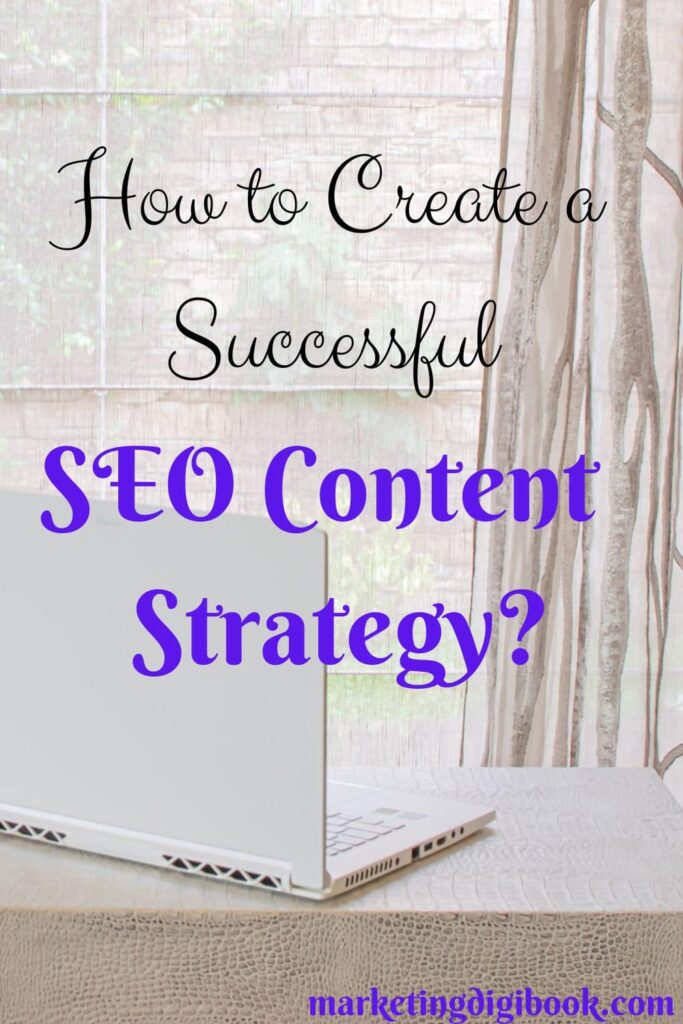Want more relevant organic traffic? Put in place an SEO content strategy to help you achieve that!
Here is how:
What Is SEO Content Strategy?
SEO content strategy is the core part of a powerful content strategy and practically decides what topics to write about, how to write them, and how to optimize them in order to rank in search engine results pages and attract organic traffic.
It includes all the tactics applied from identifying the content pillar topics and target keywords to creating content briefs and procedures of on-page optimization.
The main purpose of the SEO content strategy is to create content that will help the business reach its goals. And to offer guidelines for doing this in an efficient manner.
Having a documented SEO content marketing strategy in place has several consistent benefits:
- Keeps content creation organized and inflow
- Prioritizes tasks and allocates resources better
- Supports attracting more qualified leads into your sales funnel and ultimately improves the chances of converting more leads to paying customers
Let’s Make Your SEO & Content Work Better for Your Business
How to Create an Effective Google SEO Content Strategy?
Since Google gathers more than 90% of the search requests, it is pertinent to say that businesses looking to rank organically have to optimize for Google search.
Creating an effective SEO content strategy may be a daunting task but it will ease the operations and execution of content down the line. Thus, it is preferable to craft it from the very beginning, then have to correct and clean up after that.
SEO content strategy is an extension of the content strategy and will be built on its canvas.
Here are the detailed steps of the SEO content strategy:
Consider Each Buyer Persona and Their Buyer Journey
Even if we are discussing the content strategy from an SEO point of view, one cannot discard the fact that first and foremost you create content for your buyer persona. You need to answer its pain points, questions, and interests concerning your offer.
Your buyer personas and their associated buyer journeys were already created and established by your content strategy. As such, now you just have to transfer them to the SEO content strategy and keep them in mind when completing the subsequent steps.
Primarily you should have a clear understanding of what’s your business offer, what its goals are, why would a potential client choose your company instead of the competition, and who’s your target audience.
SEO Content Audit
Unless you are a brand new company or haven’t yet dug into content marketing, you have already published content. And you need to audit it from an SEO perspective and have a clear picture of its quality and performance in the general framework of your content strategy.
A content audit was most probably executed within your content strategy. So, now you have to take the list with the articles and pages of the site and review them taking into consideration the on-page SEO best practices.
You should verify at least the following:
- Topic and its importance for the topical authority
- Main keyword, LSIs, and PAA questions
- Search intent for the main keyword
- Content format and length
- Content structure
- Permalink
- Keyword insertion
- Images, graphics, and visuals
List all the improvements and updates that are needed and establish their priority in the function of the performance of the page and its importance for the topical authority.
The Output of the Competitor Analysis
Keeping a close eye on the competition can offer your business an edge. It’s a task that should be executed at least quarterly. Hence, the reality is quite different. Research sustains that 40% of B2C content marketers only check out their competitors yearly, if ever.
An SEO content strategy is incomplete without researching in detail what is your direct competition doing. Identify your direct competitors and check their content strategy, see what keywords they rank for, what are their most performant posts, etc.
Getting inspired by your competitors will offer some valuable insights into what is working in your niche in terms of content.
To research your competition you need an SEO and keyword research tool like Ahrefs, Moz, Semrush, or similar. Check for each competitor KPIs like:
- Domain authority (DR)
- Number of organic keywords
- Number of organic keywords in the top 3
- Monthly organic traffic
- Linking domains
- Organic traffic value

Source: Semrush
Competitors analysis can provide you with valuable content ideas, topics that you are missing, backlinks that you are missing, among others.
Metrics Setup
SEO and Marketing managers will be interested in calculating the ROI of SEO activities. And which specific activities bring the most revenue. To be able to determine that, you need to establish and monitor the key performance indicators that are relevant to your business in the next period.
The most used KPIs are:
- Organic traffic
- Dwelling time
- Number of organic keywords
- Content pieces published
- Backlinks acquired
- Number of featured snippets
- Subscribers
- Leads
- Conversions
You should be tracking your metrics at least quarterly if not monthly.
Topical Authority Should Be the Foundation of Your SEO Content Strategy
In SEO, topical authority refers to how many topics and to what extent a site covers relative to a certain topic.
For example, if you have dozens of articles published on the subject of “content strategy” and its subtopics, Google will consider you an authority on that topic. And the more semantically related keywords you cover, the more authority your site gains.
To identify all the subtopics that will help you build authority on a given topic, you have to use Google and/or a keyword research tool. And filter all the related keywords and all the semantically related ones pertinent to your topic and business.
Creating SEO content strategy based on topical authority is a laborious process, but it’s a useful methodology if you want to pop up in SERPs.
Based on Your Product/Services Identify the Key Content Pillars
Knowing what are your services/products, who’s your buyer persona, and what are your content marketing goals you can start searching for keywords and content topics.
Conduct a keyword research and identify keywords that have:
- Business potential
- Ranking perspective
- Organic traffic potential
Start by searching in Google for the term you are most interested in ranking. Use a broad term. After that check the search suggestions, PAA (People Also Ask), and related searches for the first 10-15 pages. Filter just the topics that are relevant to your business.
For example, if you offer content strategy services, you will search for “content strategy”. Additionally, you can do this in a keyword research tool like Ahrefs or SurferSEO. This will be the basis of your SEO content strategy.
Once you have this list with keywords you have to group them into topics clusters. In a tool like SurferSEO, the topics will look like this:

You don’t necessarily need a tool to do this, you can do it manually, but it will save you time.
When you have these clusters defined, prioritize them in the order of their importance for your clients, for your business, and from an SEO KPIs point of view. You also have to consider the difficulty for each keyword, the search volume, and CPC.
Your top priority is the money-generating pages, those need to be first created, fully optimized, and hopefully rank.
Then choose the topics for which you want to be an authority in your niche. And second, those for which you can rank the easiest, meaning the so-called “low-hanging fruits”. Those who need the least resources and have the greatest chance of bringing traffic and leads.
Bear in mind that your expertise and your main purpose should be the core of your content creation strategy.
Next, for each cluster brainstorm a corresponding topic. Each topic should cover and solve a buyer persona’s problem, should have a unique angle if possible, or a different approach from your competition.
Having a strong SEO content marketing strategy based on topical authority in place has a compounding effect. The more content you produce to build authority, you will rank for more keywords and your domain authority will increase and will be able to rank for keywords with higher difficulty.
Pay Attention to Search Intent
When using keywords to produce optimized content, you should also take into consideration the search intent behind that search. Meaning what the user is looking for.
Google’s supreme purpose is to offer its users what they want, in the fastest possible manner. It knows what users expect to find when making a certain query.
For example, when people are looking for “how to make pizza” Google knows they are looking for a recipe. Or when looking at “how to create a GIF”, users expect to find a how-to guide.
By figuring out the search intent you are in a better position to create more relevant content.
Thus, Google will guide you regarding the search intent behind each keyword from your list. Search each keyword on Google and identify
- The type of content you need to create – blog post, product page, video, etc.
- Content format – how-to, list, recipe, reviews, etc.
Write Search-Focused and Qualitative Content
The SEO content strategy has the purpose to equip your business with the best chances of attracting relevant organic traffic that will buy your services/products.
As a consequence, you have to produce high-quality content – meaning content that your audience finds useful, solves her problems, and drives her to consider your services.
And also search-focused content – in other words, content that is created for the correct search intent and is optimized via current on-page SEO best practices.
To create optimized and high-quality content you need first to draft content briefs and implement correct on-page SEO procedures.
Draft Content Briefs for Your Writers
If you want to create content smoothly, without many revisions and supplementary rewriting activities, creating detailed briefs is a must.
An SEO content brief includes the necessary instructions for the writer to write a correctly optimized article, with the right structure and keywords. Clear instructions and guidelines to follow. Thus offering the article the best possible chances to rank in SERPs.
In a content brief, the following information should be included:
- Title
- Summary, search intent, and angle
- Target keywords
- Target buyer persona and stage of the buyer journey
- Tone and voice
- Structure of the article (H2 headings)
- Resources
- NLP words
- Lengths of the article in words
- Deadline
You can create the briefs manually (still the best way in my view) or use a brief generation tool. There are countless tools out there ready to generate your briefs, but all of them need manual reviewing and corrections.
You can view below a sample content brief generated via SurferSeo.

Define On-Page SEO Best Practices to Be Implemented in Each Piece of Content
On-Page SEO is the foundation of SEO, it’s compulsory if one wants his articles to rank and it’s an SEO task under your control.
On-Page SEO is a must-have, as most businesses already implement it. Implementing current on-page best practices right from the writing phase will spare future efforts of rewriting and optimization.
On-Page SEO best practices are a subject of their own and you can find here a list of the most important On-Page tactics.
When Creating Content Consider the E-E-A-T Principles
Google clearly stated that a core part of its metrics revolves around E-E-A-T (Experience – Expertise – Authoritativeness -Trustworthiness). In other words, they are emphasizing the quality of the content delivered to the user.
The content produced should prove that the business has first-hand experience and expertise on the topic to be granted higher chances of ranking.
Each site will be evaluated for a certain topic based on the E-E-A-T template. It is also done for each query and for each result.
Consequently, you have to produce content for your target audience while positioning your business as an authority in your niche. And build trust.
Pay Close Attention to Your Internal Links Architecture
Internal linking structure is important for your users and search engines alike. First, your users should be able to find their way and navigate with ease your site to get the information they need. And second, search engines should be able to crawl your site and find all the published content.
Plus, search engines should be able to identify which are the most important pages for your business, the ones that you want to rank for, and the supporting pages for the latter. In addition, a pertinent anchor text will indicate to Google what keywords you are looking to rank for.
Your site’s internal linking structure is like a map with main roads and secondary streets. All connecting with each other in some way. This internal links architecture is important as the link juice is redirected from performant pages to those needing supplementary support.
Internal links play an important role in SERP ranking.
Perform SEO Content Audits Regularly
To continuously improve your site rankings you have to keep an eye on your most important keywords. Track them with a keyword research tool to help you identify ranking improvement opportunities.
It’s not enough to write and publish qualitative content. You have to perform audits, update it and review it periodically.
There are several reasons to do that. It might happen that your content doesn’t rank or it loses rankings. Or search intent changes. Or content gets outdated.
Search engine algorithm updates are frequent and SERPs are dynamic, they change continuously.
When executing an SEO content audit you have to check on the following:
- What is the situation of your traffic? Is It growing, stalling, or decreasing?
- Which are the most performing pages? Which drive the most traffic? How about conversions?
- Which pages do you need to rank and they actually don’t rank for the right keyword?
- What can you do to improve the rankings?
Based on this information you can adjust your future plans. Prioritize performing pages, update those that are less performant following the model of those that bring the most results, etc.
Keep an Eye on Google Algorithm Updates
There is no news that Google updates its algorithm several times a year (core updates). Even if minor updates might not impact your rankings, core updates may at times have a significant impact.
Consequently, you have to keep updated about what future algorithm updates require to maintain the performance of your content and site.
Conclusion
A date-based and successful SEO content strategy is an absolute must if you want to attract organic traffic in a more complicated and crowded environment. Plus, the challenges brought by the newly developed AI technology. Following the above-mentioned steps and keeping yourself updated will help solve future challenges.
If you find creating an SEO content strategy a daunting task, ask for professional help.
The top 5 SEO strategies may be considered the following:
High-Quality Content Creation
Topical Authority
On-Page SEO
Off-Page SEO
Technical SEO
An SEO content plan is a document that clearly defines what content will be created, what keywords will be targeted, guidelines for content creation, and on-page optimization. All these have the purpose of reaching the business goals.
SEO is a core part of a content marketing strategy. SEO doesn’t exist on its own without a content strategy.
The key to successful SEO is clearly defining your business goals and defining and implementing an SEO content strategy to show you how to reach those goals.
To integrate SEO into your content, you should put in place an SEO content strategy to define the keywords to rank for, the topics to write about, and the guidelines for on-page SEO optimization.
Yes, SEO is a core part of the content strategy.
The core part of a content strategy is creating content that is considered useful by the buyer persona and is optimized to rank in search engines. Its mission is the help reach the business’s goals.
The 3 C’s of SEO may be considered content, credibility, and conversion.
The meta description is not the same as the content. It is a brief summary of a page and is an HTML element.






